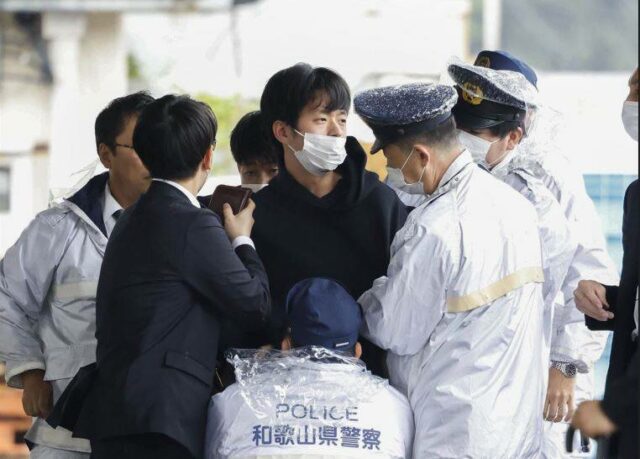
The Rising Danger From Crude, Homemade Weapons and Political Violence in Japan
Publication: Terrorism Monitor Volume: 21 Issue: 12
By:

On April 15, Japanese Prime Minister Fumio Kishida was attacked with a homemade explosive device while attending a public campaigning event in Wakayama, a city 50 miles south of Osaka (Japan Times, April 15). This attempted assassination was chillingly reminiscent of the assassination of former PM Shinzo Abe on July 8, 2022. These two high-profile attacks on Japanese leaders in the space of a year are alarming in a country known for its relative safety and stability. These incidents indicate the continued threat posed by two main issues: first, lone actors without specific political ideologies who appear to have grievances against the government; and, second, the danger of crude, homemade weapons.
The Attempted Kishida Assassination
As Kishida arrived at a fishing village to deliver his speech, 24-year-old Ryuji Kimura hurled an explosive device at him. The device failed to detonate on impact and exploded 50 seconds later, damaging a nearby warehouse. By this time, Kishida had been moved to safety (@gmix560, April 15); no one was hurt except for a police officer, who sustained minor injuries (Mainichi.jp, April 15).
The device was a homemade pipe bomb that was constructed using commercially available materials, to include 8-12 inch metal pipes, a fuse, gunpowder, and metal nuts (Mainichi.jp, April 20). Police believe Kimura learned to construct the device from instructions available on the internet (Mainichi.jp, April 22). They also noted that the bomb would have been lethal if it had flown at a lower trajectory (Asia News Network, April 19). The fact that it did not explode immediately was likely due to defects from the bomb’s construction. Kimura was also in possession of a knife and a second bomb, and police seized approximately 90 items including a laptop, tablet, and bomb-making materials from his home (The Japan News, April 18).
Although the actual motive of Kimura’s attack remains unclear, he had expressed grievances and dissatisfaction towards the government before the attack. Last year, for example, Kimura filed a lawsuit against the government for barring him from running in an election. This ban was due to his age and inability to provide a three million Yen deposit ($20,000) (The Japan Times, April 18).
Similarities with Shinzo Abe’s Assassination
Kimura’s attack bears a marked resemblance to the assassination of Shinzo Abe. Firstly, both cases involved lone actors who used homemade weapons made from commercially available parts. In the Abe case, the perpetrator, 41-year-old Tetsuya Yamagami, shot Abe with a homemade gun made from pipes, wood, and a simple electrical circuit (The Japan Times, July 10, 2022). All the materials were bought commercially, and he had likely learned to construct it on the internet (The Japan Times, July 10, 2022).
The second similarity is modus operandi. Both attacks involved targeting national leaders in public settings. Like Kishida, Abe was attacked while delivering a campaigning speech in front of a crowd of people in an open space in Nara, a city 20 miles east of Osaka. The third similarity concerns ideology and motive. Both attackers were not known to have adhered to any specific political ideology and were not part of a larger, organized group. Nevertheless, both had a sense of dissatisfaction toward the government, which may have been in the form of personal grudges. Yamagami attacked Abe due to the latter’s links with the Unification Church, which he blamed for “destroying his family,” after his mother spent large sums of money on donations to their organization (The Guardian, January 10).
Conclusion
While both of these attacks have received significant domestic and international attention, such assassinations and attempted assassinations are not unprecedented. Japan has historically been a stranger to neither individually motivated nor organized political violence. The earliest assassination attempt on a modern Japanese leader dates back to the 1920s, when then Prime Minister Takashi Hara was stabbed to death by a disillusioned railroad worker (The Japan Times, July 8, 2022). Ever since then, there have been at least 11 assassination attempts on political leaders, of which at least six were perpetrated by Japanese far-rightists and/or ultra-nationalists (The Straits Times, July 8, 2022).
As with any attack perpetrated by a lone actor, the lack of a wider network (whose communications may be intercepted or otherwise flagged) provides a serious challenge for security services. Additionally, the rising use of crude, homemade weapons made from commercially available materials and constructed with instructions found online makes disrupting the attacks exceptionally difficult. Although these weapons may not have the capability for mass destruction, they can be used to cause harm at a smaller, localized scale to great effect, as seen in the Abe case.
Caution must be taken when drawing conclusions from two isolated incidents, however. These could be placed simply within the context of being violent acts by lone individuals, rather than anything “terroristic.” At the same time, the choice of target highlights an implicit political motivation, pointing towards a trend that should concern Japanese security officials. More broadly, these incidents show that the danger arising from lone actors with crude weapons can be unpredictable, something officials in Japan and elsewhere will need to address.



